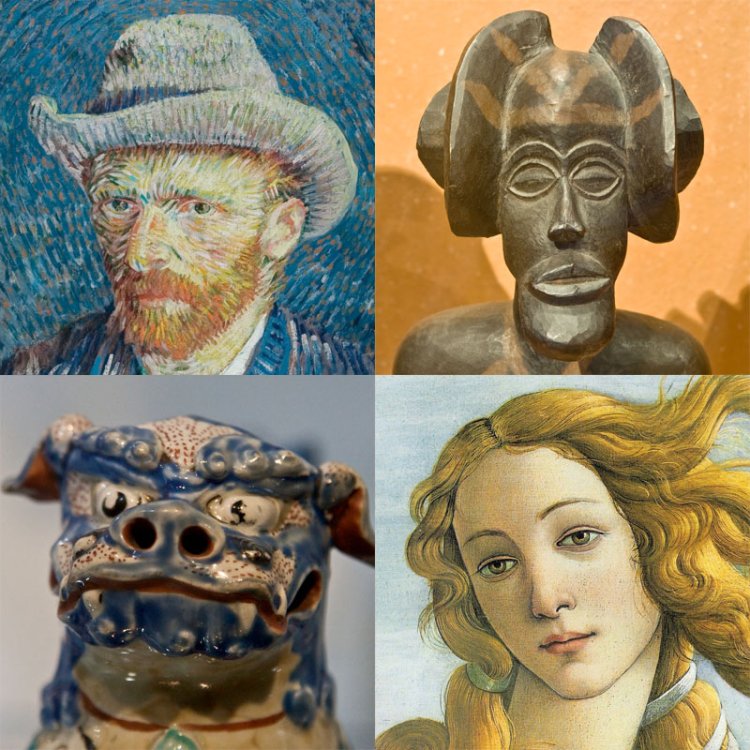Arts
The arts encompass a vast spectrum of human activities involving imaginative thought, narrative construction, and cultural engagement.

What is Art? Why is Art Important?
Define art. – In accordance with the dictionary, "the conscious use of skill and creative imagination especially in the production of aesthetic objects" constitutes the definition of art.
However, the beauty of art is that its diversity means that there are as many interpretations of it as there are viewers. This is why there are academics who provide their own unique definitions of the term, as the one written by this well-known Russian novelist:
"Art is the action by which a person who has felt something conveys that feeling to others." Tolstoy, Leo
Tolstoy's most renowned work, "War and Peace," draws heavily on his experiences in the Crimean War, as well as other events from his life.
Whether or not you agree with his concept of art, the point is that everyone has a different perspective on art because of their unique life experiences
 .
.
What is Art?
Many different definitions of art are commonly used. Several examples:
As discussed in the accompanying article, "What is Beauty in Art?," the beauty inherent in the act of making something aesthetically pleasing lies in the doing rather than in the magic of the method.
the discovery and development of simple principles of nature into beautiful forms suited for human use (Frank Lloyd Wright); the world's most intensive method of individualism (Elbert Hubbard); the mastery, a perfect way of doing things; not a thing; it is a way.
Many different definitions of art are commonly used. Several examples:
As discussed in the accompanying article, "What is Beauty in Art?," the beauty inherent in the act of making something aesthetically pleasing lies in the doing rather than in the magic of the method.
the discovery and development of simple principles of nature into beautiful forms suited for human use (Frank Lloyd Wright); the world's most intensive method of individualism (Elbert Hubbard); the mastery, a perfect way of doing things; not a thing; it is a way.
Why is Art Important?
Van Jones's idea, which presents a nuanced yet effective response to the question "What is art?", is the one I like the most.
Van Jones provided a graph that adequately depicts the interplay between these four groups and the various individuals who make up society.
Therefore, Vones illustrates the question, why is art significant to human culture?
Below is a graph depicting modern society.
Influential people, reliant people, the state, cultural creators, and creatives all drive society.
The masses are on the bottom, and the elites are at the top; ideas are on the left, and action is on the right. There's both an internal and an external performance.
Millions of dollars are being spent by the privileged to sway politicians and policymakers. The inner act might sway those who make laws.
We at the grassroots lay out our demands publicly, and the elected representatives respond by enacting laws that give us authority. What the people desire (at their core) is what the masses want.
"Action," over on the left, usually refers to observable shifts in approach. The "ideas" side, on the right, is sometimes more obscured. This discussion is not about material objects but rather a mental state.
A culture of thought relies heavily on academic institutions and think tanks, which are not necessarily involved in the immediate policy gains.
The left side, "action," continues to yield measurable policy shifts and new laws, while the right side, "ideas," can be impossible to quantify. While "head" is good at talking theories and academics, it provides little useful input to policymakers.
At this point, creatives enter the picture.
Here, artists take up ideological position in the "heart space."
Art is in a special position to elicit emotional responses from viewers, including awe, wonder, enthusiasm, and even outrage.
Artists have the power to inspire and motivate people to take action. They lack the analytical abilities of politicians and scholars.
Artists' ideas come straight from the heart, and they're often radical and far-reaching.
Because of this, art has the power to inspire change and has made enormous political and cultural contributions throughout history.
That's the magic of art, right there.
Impact of Art on Politics, Culture, and People
Art is crucial to society because it helps people feel more confident in themselves.
Art that appeals to the emotions of society's elite and powerful is what campaigners use when exhibiting photos of youngsters suffering from poverty or injustice in their campaigns.
Photos of war-torn countries published online have a similar effect, drawing the attention of people whose sympathies naturally go out to the victims.
The world is a better place when talented people release new music and films that everyone may enjoy. This is art that matters in the world.
Street art is a dynamic and cutting-edge form of visual expression. The painting at Kreuzberg, painted by renowned Italian street artist Blu, provoked a wide range of responses based on long-standing tensions between East and West Berlin.
Who knew a painting of two anonymous people trying to expose each other would cause such a stir?
The real story behind this artwork is something else entirely. Whether or whether the mural's intended effect was achieved, the power of a well-executed work of art to influence its audience cannot be ignored.
Art is also a remarkable mode of depicting culture from all over the world
You can tell that Zen gardening is a Chinese tradition just by looking at a Zen garden in Sydney or San Francisco.
Similarly, if you've ever been to a wedding and seen hundreds of paper swans fluttering around, you've witnessed the Japanese art of origami.
You can always tell an Indian film by its use of Bollywood music and dance. Art has the potential to uproot local customs, move them to new locations around the world without altering their essential character.
There, they can be utilized to amuse, raise awareness, and even motivate people from other cultures to accept the strangeness and otherness of these communities.
And this is precisely what John Dewey suggests in his book "Art as Experience":
When we join the spirit of Negro or Polynesian Art, barriers fall away and limiting prejudices melt away. This kind of unconscious softening is much more effective than the change brought about by logic, because it goes straight to the heart of one's outlook.
In today's interconnected global community, this is more vital than ever.
The arts have been instrumental in the struggle against racial discrimination, cultural bigotry, and other types of social injustice.
As international migration increases, nations around the globe are being pushed to become more welcoming and accommodating.
Art plays a vital role in achieving this goal by ensuring that people's individuality and cultural traditions are respected everywhere they go.
Why is Art so Powerful?
The shortest and most direct response would be that art makes us feel something.
Art has the potential to impact not only our culture and politics but also our economy. When we experience a moving piece of art, it resonates with us on a fundamental level, inspiring us to take action.
Leo Tolstoy said it best when he said:
People's ability to share and absorb the feelings of others is vital to the artistic process. Whether the reader, the viewer, or the listener experiences strong or weak feelings, important or irrelevant emotions, pleasant or bad emotions, the work has fulfilled its purpose as art.
To sum up, the following are only few of the many reasons why art is so potent:
It may be used to teach just about any subject to anyone. It has the potential to raise consciousness and convey data in a style that is easily digestible by a wide audience. Art makes education a better equalizer in a world when some people don't even have access to a basic one.
The tech-obsessed millennials of today will benefit from learning to appreciate other cultures. Indeed, one could argue that without art, our past, present, and future are even more threatened by oblivion.
It's a unifier in terms of society, economy, and culture. Art may not be able to eradicate poverty or advance social justice, but it can serve as a forum for both. Everyone has feelings and experiences, which makes art universally relatable. This means that people of all ages, economic backgrounds, and political persuasions can develop an appreciation for art.
It allows you to think on a more complex level. Art does more than merely aid with memory retention. Instead, it gets you to reflect about modern concepts and motivates you to come up with your own. Reason enough to consider creativity a sort of intelligence: it's a key that allows us to access our whole mental capacity. In fact, research shows that being exposed to art can improve performance in other domains of learning as well.
The truth is that people now understand the significance of art.
There have been several cases throughout history where artists have been persecuted (including criticism, threats, censorship, and even murder) for their work.
Those responsible for these responses, be it a hostile government or a rebel organization, act against artists knowing full well the impact their work might have on regional politics.
Art, however, in the hands of decent people, can be used to restore hope or instill courage in a culture that is facing a great deal of adversity.
Great Art elicits powerful sentiments and tells meaningful stories
Entertainment and joy are key goals of many artistic genres, including film, music, theater, and popular culture. Art becomes more varied when it is created for a particular audience or function, such as when a film, song, or play is created.
Awareness and cultural appreciation, for instance, can be disseminated through the medium of film. Songs can be written to elicit specific feelings from listeners, as well as to provide motivation and lift spirits.
In Victorian England, women artists like Elizabeth Sirani's "Portia Wounding Her Thigh" began to gain recognition for sending a message that women were finally ready to separate themselves from gender stereotypes.
The woman in the painting displays strength comparable to that of a male. Since "Portia" isn't the stereotypical weak, gossipy woman, she stands in for giving up.
One of the seminal works that demonstrated the strength of women artists and helped to break down barriers for women in the arts at large.
Art can also spark profound philosophical debate, the kind that challenges accepted wisdom and inspires people to alter their ways of living.
Still, art can serve as a bridge to connect with someone who understands and can relate to the artist's inner world.
In reality, painting is much more than a hobby; it's a way of life. Being creative is more than just a hobby or a profession. All works of art have meaning beyond their visual appearance.
It's not surprising that we've always incorporated art into our daily lives, given how closely it relates to the human experience.
One of the main reasons why art is essential is that ancient and modern indigenous communities all over the world have a flair for blending it into their traditional items or rituals without even realizing it. The therapeutic value of art is often overlooked.
Some people think that art is dull. However, it cannot be denied that art has the potential to uproot cultural traditions from their original contexts and transplant them to new locations without compromising their integrity.
There, they can be utilized to amuse, raise awareness, and even motivate people from other cultures to accept the strangeness and otherness of these communities.
In today's interconnected global community, this is more vital than ever.
The arts have been instrumental in the struggle against racial discrimination, cultural bigotry, and other types of social injustice.
As international migration increases, nations around the globe are being pushed to become more welcoming and accommodating.
Art plays a vital role in achieving this goal by ensuring that people's individuality and cultural traditions are respected everywhere they go. To answer the question "What is art?" it is necessary to first consider the "Why art is important" question.
For this reason, we at The Artist consider artistic expression to be a fundamentally human activity and a means of enhancing the human condition.

NFTs: The Future of Art
The art world is currently undergoing a transition toward digital and alternate forms of expression. There is a major shift happening, and NFT is becoming a pivotal factor in it.
What is NFT artwork?
The term "non-fungible token" (NFT) refers to a digital asset that may be exchanged quickly and easily between users on a blockchain.
Since they can be tracked, have value, and are frequently quite rare for collectors, many people all around the world are looking for these digital assets to sell and trade in their regular market transactions.
While creative works do play a role in the NFT industry, game platforms, avatars, and even full-fledged virtual worlds are also attracting new participants.
While most people can't afford these tokens, serious investors have found that NFTs can be a lucrative source of revenue due to their versatility.
Conclusion: Why is art important to human society?
The nature of art and how it is defined will forever be up for debate.
Arguments about the nature of art will continue indefinitely.
Yet in whatever form it takes (cave drawings, hieroglyphics), it has always been part of human culture.
The arts have an impact on our life whether we acknowledge it or not, and there are numerous reasons for this.
The arts have a variety of purposes for humans, from amusement and self-improvement to cultural understanding and societal transformation. The arts are essential to our survival in this planet.
I'm interested in hearing your take on this; what does art mean to you?












